A storm is brewing in a cavernous warehouse in Port Richmond. For over a year, New York-based, Tyler School of Art-educated artists Chris Klapper and Patrick Gallagher have been working in this 30,000-sq. ft., donated studio/warehouse to realize their first collaborative piece: Symphony in D Minor, an epic, interactive installation with sculpture, video and audio, which will allow participants to create a symphonic thunder storm.
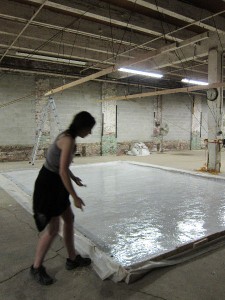
Opening at The Skybox at 2424 Studios on October 20, Symphony in D Minor is the artists’ most ambitious project to date. A large-scale installation like this is possible in Philadelphia because of the massive space offered at the Skybox, and the significant curatorial support of Eileen Tognini, who, along with her assembly of contacts and allies, brings artists’ ambitions to life.
“If we’re going to spend money on anything, it’s going to be on the best respirators.” Chris is explaining the chemistry of the resins and liquid chemical mixtures Patrick and she combine in order to make four, 22 ft. long, 6 ft. in diameter resin and fiberglass cylinders. In the final installation, these four sculptures will hang from the rafters of The Skybox at a height of 6′ 5″ — a height that looms ominously overhead but that also irresistibly invites you to reach up and try to touch them. The piece is inspired in part by the Arcus clouds that hail the imminence of a thunderstorm.
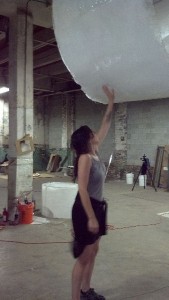
The surfaces of these sculpture-cylinder-clouds are smooth and shiny; they feel nice to the touch. Hand-cast from resin poured into a custom made mold, they seem to maintain some of their original liquidness, and they retain a wavy, watery pattern on the surface. They are certainly sculptures in their own right and hanging side by side from the ceiling of The Skybox, they may for a moment resemble the repeating geometric units of Minimalism. But for this project, these cylindrical objects are also clouds and musical instruments.
The resin casings will be wrapped around a steel framework weighing in at about 300 pounds and hanging from hinges. allowing the objects to swing back and forth. To be a participating musician in Symphony in D Minor, you’ll have to stretch up (or be hoisted up) and push against the weight of the sculptures to activate the sounds of the piece. You’ll notice the effort in your body and, once moved, each cloud will contribute a note to the symphony’s score – thunder, wind, rain, or lightening. Symphony in D Minor will be a physical, aural, and visual experience; a synesthesia of sorts.
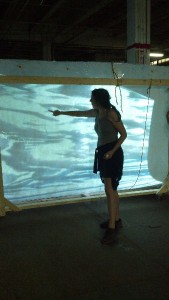
Here’s how the thunderstorm sounds will be made. Each cylinder contains hand-made (with the assistance of You Tube, notes Chris) computer sensors which measure and track the cylinder’s movements and then trigger both the storm sounds as well as an intricate, interior video that will project onto the cylinder’s inside shell. Partick notes that there are five complex computer programs working together to control the many layers of video and audio production for this project.
Sounds for each of the four cloud-instruments are a combination of recordings made by the artists and free, shared audio files made by a recordist in Idaho whose pristine storm recordings were captured in the vast and echoing wilds of the mountainous West. These recordings, according to Patrick, have a particularly intense quality. The entire symphony is approximately forty minutes long and has a pre-arranged structure in four parts that mimics the entry and exit of a storm.
But all notes elicited by the moving cloud sculptures are up to participants; the layered, resonating sounds result from chance having to do with which cloud gets moved first or last, for how many times, and how hard it is pushed. All of these undeterminable elements will make a lasting and resonating symphony inspired by Aleatoric music, where chance elements are accommodated within a pre-set structure of possibilities. In this regard, the artists note their admiration for John Cage and Merce Cunningham. As long as participants move the cloud sculptures, the sound will continue, build, and reverberate. The artists anticipate an elongated resonance of sound that may add a powerful and contemplative element to the piece.
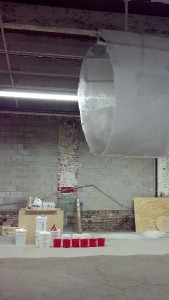
As for the video projection inside the cylinders, it looks beautiful. Moving across the inside surface of the cloud sculptures will be abstracted images and colors of storm cells and skyscapes that will also change according to the chance movements. Originally a painter, Patrick describes the affinity of these visuals to Color Field Painting, noting that within the larger dramas of nature there are always smaller abstractions to be found. The video imagery reflects this idea, showing at times horizontal bands of color or stripes of grays and water droplets. The effects of dappled light and naturalism are captured dramatically.
The natural world has served as inspiration for artists forever, and Chris and Patrick become a part of this lineage with this project. They’ll bring the drama of a thunderstorm, and all of its symphonic possibilities, into the immense gallery space, and give people the opportunity to participate in what may indeed feel like a sublime, Romanic re-presented landscape. It will be interesting to see people move the big cylinder-clouds, or to see bodies helping other bodies make that movement happen; adults holding up brave-enough children.
Moving the big, heavy clouds will take some noticeable exertion, which seems only fitting for the task at hand. After all, making thunder and lightning is a job typically reserved for the gods. Interestingly, a Zeus-like purview will be available at The Skybox from the second floor, balcony level, and if we look down we will see mortals trying to move clouds and bring on the sounds of lightning and thunder.
Patrick and Chris have been collaborating as married partners for 22 years, but Symphony in D Minor is their first official art collaboration. They are devoted artists, and have worked for a year and half on this project, constantly raising money and working with chemical and structural engineers to realize their vision. Taking a tour of their studio and seeing firsthand the amount of work and level of production going into this project is breathtaking. It’s just more evidence that artists work incredibly hard, both for themselves but also for us. It seems that with Symphony in D Minor, Chris Klapper and Patrick Gallagher may accomplish what a lot of artists do best – make us notice and listen in new ways.
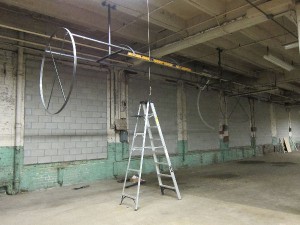
The opening for Symphony in D Minor is Saturday, Oct. 20, 7:00 – 10:00pm. Special solo performances by Kun-Yang Lin will take place on opening night at 7:30 and again on Friday, Nov. 2 and Sunday, Dec. 2, both at 7:30. Lin will create improvisational dance in dialogue with Symphony in D Minor. Symphony in D Minor is part of POST.
Video and audio samples of the project can be found here.
—Jennifer Zarro is an art historian and writer in Philadelphia.





